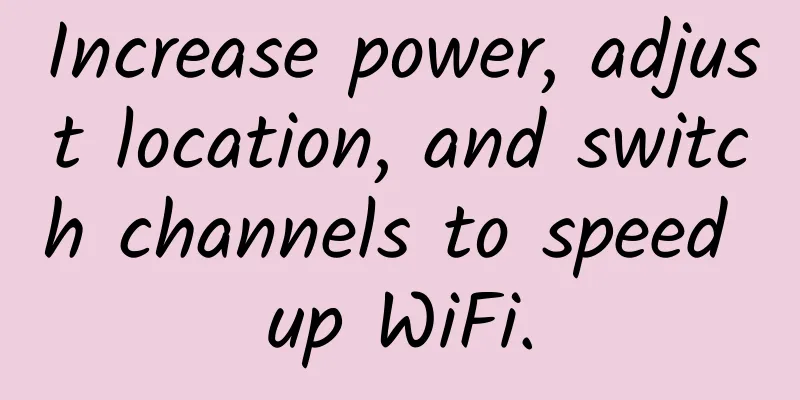Increase power, adjust location, and switch channels to speed up WiFi.

|
Have you adapted to your daily work and life after the 7-day Spring Festival holiday? Many friends said that they stayed at home during the Spring Festival, but the WiFi signal at home was not good, which made them very annoyed. Don't worry, learn the following three tricks to improve your WiFi experience! Let's improve the home WiFi signal from three aspects: transmission power, wireless channel, and placement! Improving wireless transmission powerFirst of all, we can adjust the transmission power of the router in the background while keeping the position of the router unchanged. By default, the transmission power of many wireless routers is much lower than their maximum power, which makes it possible for us to adjust the strength of the wireless signal. In the settings of wireless routers, the higher we adjust the transmission power, the better the coverage and strength of the wireless signal will be. Many routers do not provide the option to increase the specific power value in the background. We can directly select "wall penetration mode" or increase the transmission power. Wireless signal frequency band usageSecond, since almost every household has deployed wireless networks, we can see many wireless network names by just searching at home. If the wireless networks of these neighbors are consistent with the wireless channels of our home routers, they may cause interference with the wireless channels, causing the network to slow down. Because wireless channels are an issue that users don't notice, we can use professional software (such as WirelessMon) or the router app to check the usage of surrounding wireless channels. Or you can scan the surrounding environment in the system background of the wireless router and the mobile app to check the surrounding wireless channels. Manually switch to an idle channel to reduce co-channel interference. Or connect to the 5Ghz frequency band of the router at home to reduce co-channel interference. Place the router in the center of the roomFor users living in small and medium-sized households, placing the wireless router in the center of the room is undoubtedly the best choice. Since the antenna gain of most home wireless routers is 5dBi, placing the wireless router in the center of the room will allow users to experience the best wireless network in every room. Placing it in a weak current box will significantly reduce the WiFi qualityHowever, this is only an ideal state. Because many developers design the weak current box at the entrance when designing the living room layout, the optical modem and network cable are locked in the iron cabinet at the entrance, and the wireless router is often seen locked in it, which will greatly attenuate the WiFi signal. Here, you only need to connect the network cable of the network panel in other rooms to the network port of the optical modem, and then connect a wireless router to the network port of each room through the network cable, and you can achieve full WiFi signal in each room. |
Recommend
IntoVPS: Hourly KVM monthly fee starts at $5 ($0.0075/hour), 6 data centers available
IntoVPS is an unmanaged VPS hosting brand launche...
Quickly understand the core components based on Netty server
Thanks to Netty's excellent design and encaps...
Experts discuss: How will 5G accelerate after the epidemic?
It was supposed to be a time to get rid of the ol...
Daily Bug Troubleshooting-All Connections Suddenly Closed
Preface The daily bug troubleshooting series is a...
AlphaVPS: German AMD EYPC+NVMe series KVM is online with monthly payment starting at 3.99 euros
At the beginning of last month, I shared the news...
The latest data on 5G construction is released: huge potential and promising future
As the COVID-19 epidemic is gradually under contr...
CentOS8 installation screen prompts No match for argument: screen
CentOS8 has been released for some time. I person...
China's operators' semi-annual report: 5G package users close to 500 million
On August 19, China Unicom announced its first-ha...
Cartoon | IPv6 makes every grain of sand under your feet unique
I am an ordinary grain of sand in the vast sea of...
2G quietly withdraws from the network, 4G grows steadily, and it is still a bit far to talk about 5G now
The withdrawal of 2G/3G networks is not a new top...
How does DNS affect your surfing speed?
This article introduces DNS-related knowledge in ...
5G is not for demonstration, but for use: my country has entered the second half of 5G
Simply put, demonstration and use are two differe...
Cisco, the hero behind the scenes who helps turn good thoughts into good deeds
People often have good intentions in their hearts...
City managers can now predict the future using 5G and digital twins
Digital twins, or DTs, are data-enabled city mode...
Which is faster, 5G or Wi-Fi 6? A hardcore comparison tells you
[[388609]] My wife, who has always been worried a...









